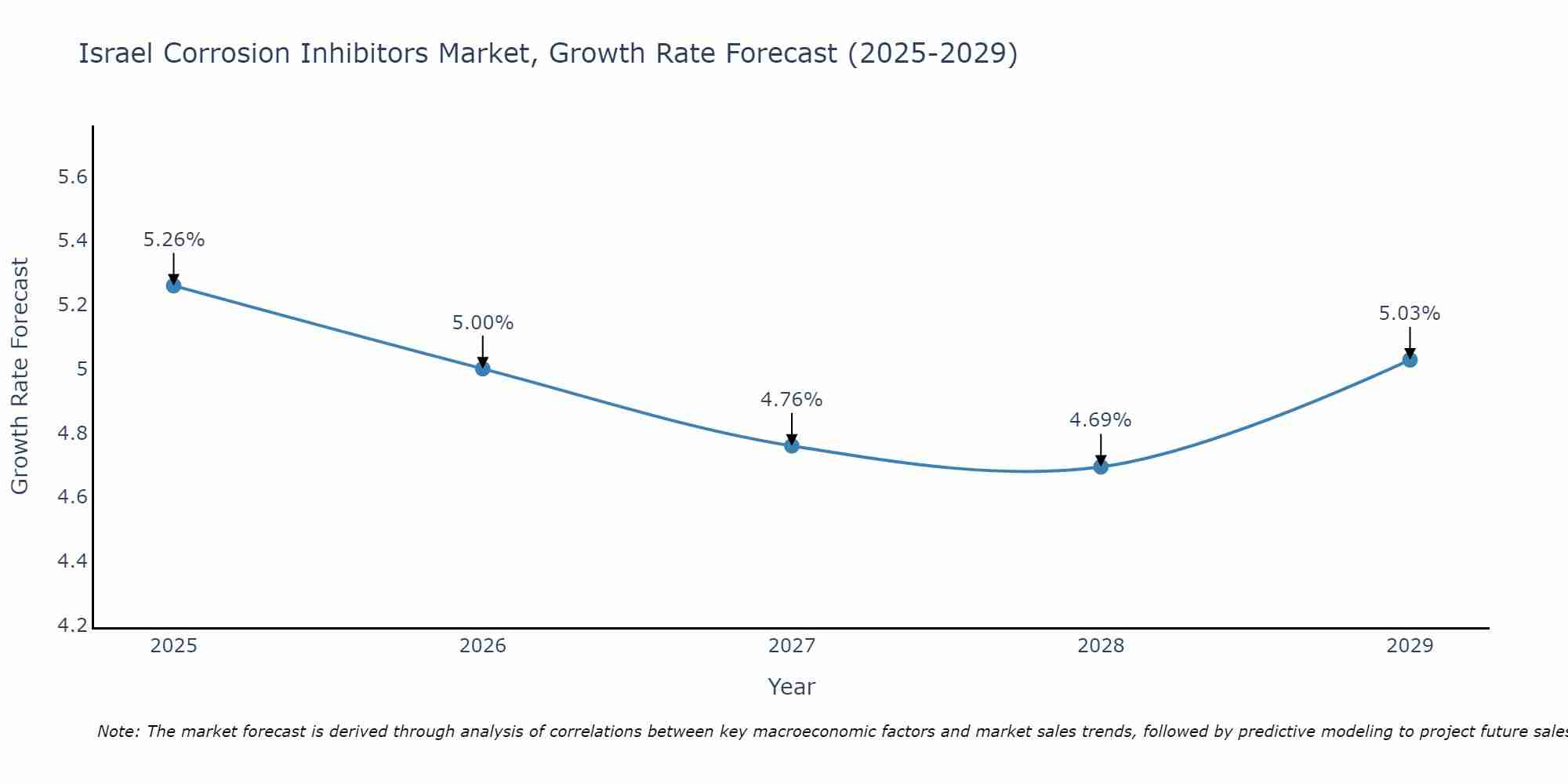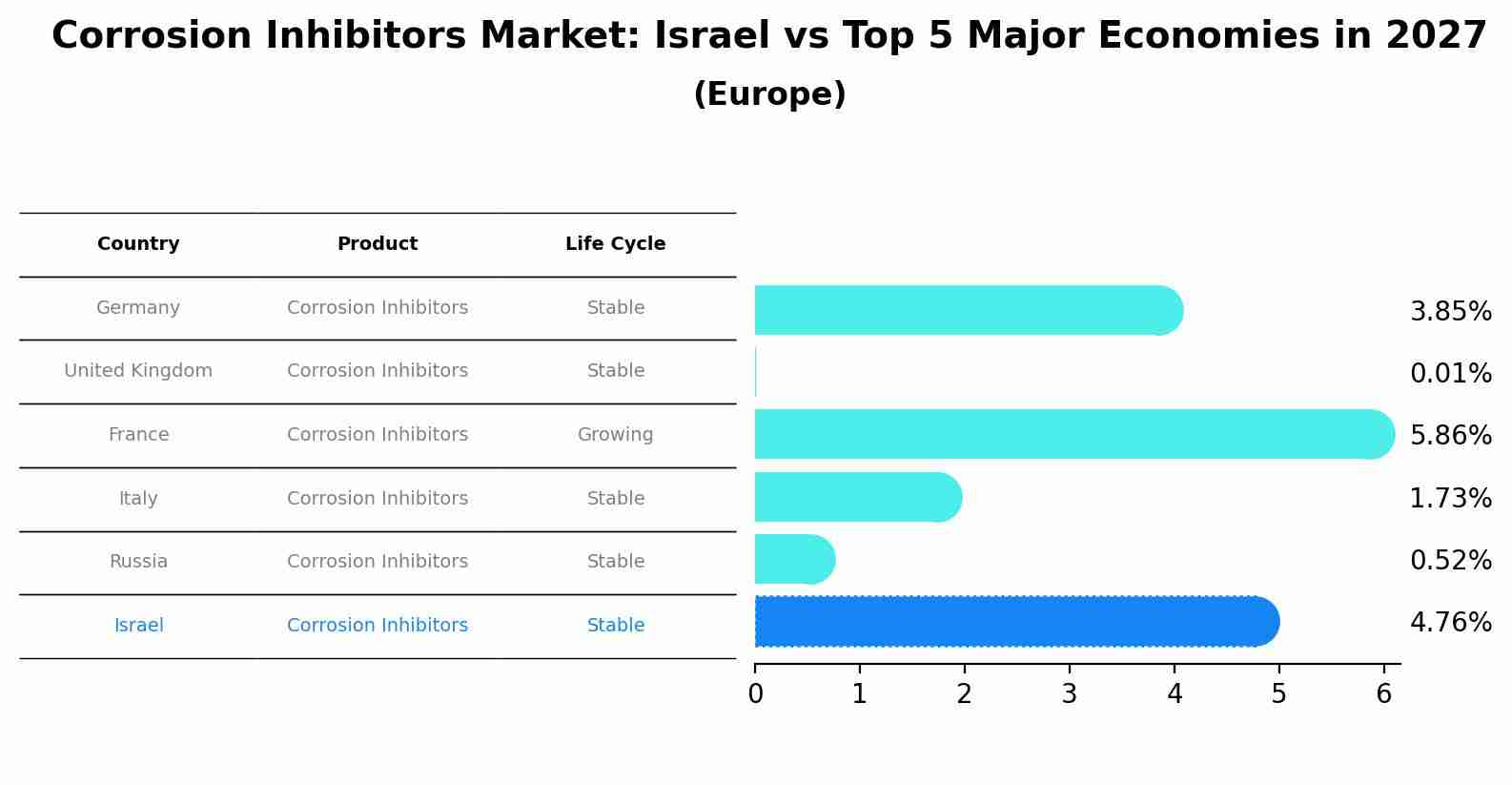Israel Corrosion Inhibitors Market (2025-2031) | Outlook, Companies, Growth, Segmentation, Share, Size, Value, Industry, Forecast, Analysis, Trends & Revenue
| Product Code: ETC4665954 | Publication Date: Nov 2023 | Updated Date: Apr 2025 | Product Type: Market Research Report | |
| Publisher: 6Wresearch | No. of Pages: 60 | No. of Figures: 30 | No. of Tables: 5 | |
Israel Corrosion Inhibitors Market Size Growth Rate
The Israel Corrosion Inhibitors Market is projected to witness mixed growth rate patterns during 2025 to 2029. Starting high at 5.26% in 2025, the market steadily declines to 5.03% by 2029.

Corrosion Inhibitors Market: Israel vs Top 5 Major Economies in 2027 (Europe)
By 2027, the Corrosion Inhibitors market in Israel is anticipated to reach a growth rate of 4.76%, as part of an increasingly competitive Europe region, where Germany remains at the forefront, supported by United Kingdom, France, Italy and Russia, driving innovations and market adoption across sectors.

Israel Corrosion Inhibitors Market Synopsis
Corrosion inhibitors play a vital role in protecting metal surfaces from degradation caused by corrosion. In Israel, this market may be driven by the country`s industrial sectors, including manufacturing, petrochemicals, and infrastructure development. Key players in this market likely offer a range of corrosion inhibitors tailored to specific applications and environmental conditions, emphasizing their effectiveness in prolonging the lifespan of assets and reducing maintenance costs.
Drivers of the market
The Israel Corrosion Inhibitors market is witnessing growth owing to the widespread adoption of corrosion prevention strategies across industries such as oil & gas, marine, and manufacturing. Corrosion inhibitors play a crucial role in protecting metal surfaces from degradation caused by corrosion, thereby extending the lifespan of equipment and infrastructure. With increasing investments in infrastructure development and the expansion of industrial activities, there is a growing demand for corrosion inhibitors to mitigate the economic and safety risks associated with corrosion, thus driving market growth.
Challenges of the market
The Israel Corrosion Inhibitors market confronts challenges related to product efficacy, environmental concerns, and regulatory compliance. While corrosion inhibitors play a vital role in protecting infrastructure and equipment from corrosion damage, concerns persist regarding their environmental impact and long-term effectiveness. Stricter regulations governing the use of hazardous chemicals in corrosion inhibitors compel manufacturers to develop eco-friendly alternatives without compromising performance. Additionally, the diverse nature of corrosion processes across industries necessitates tailored solutions to address specific corrosion challenges effectively. Meeting these requirements requires investments in research and development, collaboration with regulatory bodies, and proactive engagement with customers to understand their unique corrosion mitigation needs. By offering innovative, sustainable, and cost-effective solutions, market players can overcome these challenges and capitalize on the growing demand for corrosion protection solutions in various sectors.
Government Policy of the market
Government regulations in Israel mandate the use of corrosion inhibitors in various industries to protect infrastructure and equipment from degradation. The government works closely with industry stakeholders to develop and enforce standards for the use of corrosion inhibitors, promote research into new technologies, and ensure compliance with environmental regulations.
Key Highlights of the Report:
- Israel Corrosion Inhibitors Market Outlook
- Market Size of Israel Corrosion Inhibitors Market, 2024
- Forecast of Israel Corrosion Inhibitors Market, 2031
- Historical Data and Forecast of Israel Corrosion Inhibitors Revenues & Volume for the Period 2021-2031
- Israel Corrosion Inhibitors Market Trend Evolution
- Israel Corrosion Inhibitors Market Drivers and Challenges
- Israel Corrosion Inhibitors Price Trends
- Israel Corrosion Inhibitors Porter`s Five Forces
- Israel Corrosion Inhibitors Industry Life Cycle
- Historical Data and Forecast of Israel Corrosion Inhibitors Market Revenues & Volume By Product for the Period 2021-2031
- Historical Data and Forecast of Israel Corrosion Inhibitors Market Revenues & Volume By Organic for the Period 2021-2031
- Historical Data and Forecast of Israel Corrosion Inhibitors Market Revenues & Volume By Inorganic for the Period 2021-2031
- Historical Data and Forecast of Israel Corrosion Inhibitors Market Revenues & Volume By Type for the Period 2021-2031
- Historical Data and Forecast of Israel Corrosion Inhibitors Market Revenues & Volume By Water Based for the Period 2021-2031
- Historical Data and Forecast of Israel Corrosion Inhibitors Market Revenues & Volume By Oil Based for the Period 2021-2031
- Historical Data and Forecast of Israel Corrosion Inhibitors Market Revenues & Volume By End-use for the Period 2021-2031
- Historical Data and Forecast of Israel Corrosion Inhibitors Market Revenues & Volume By Power Generation for the Period 2021-2031
- Historical Data and Forecast of Israel Corrosion Inhibitors Market Revenues & Volume By Oil & Gas for the Period 2021-2031
- Historical Data and Forecast of Israel Corrosion Inhibitors Market Revenues & Volume By Paper & Pulp for the Period 2021-2031
- Historical Data and Forecast of Israel Corrosion Inhibitors Market Revenues & Volume By Metal Processing for the Period 2021-2031
- Historical Data and Forecast of Israel Corrosion Inhibitors Market Revenues & Volume By Chemical Processing for the Period 2021-2031
- Historical Data and Forecast of Israel Corrosion Inhibitors Market Revenues & Volume By Water Treatment for the Period 2021-2031
- Historical Data and Forecast of Israel Corrosion Inhibitors Market Revenues & Volume By Others for the Period 2021-2031
- Israel Corrosion Inhibitors Import Export Trade Statistics
- Market Opportunity Assessment By Product
- Market Opportunity Assessment By Type
- Market Opportunity Assessment By End-use
- Israel Corrosion Inhibitors Top Companies Market Share
- Israel Corrosion Inhibitors Competitive Benchmarking By Technical and Operational Parameters
- Israel Corrosion Inhibitors Company Profiles
- Israel Corrosion Inhibitors Key Strategic Recommendations
Frequently Asked Questions About the Market Study (FAQs):
1 Executive Summary |
2 Introduction |
2.1 Key Highlights of the Report |
2.2 Report Description |
2.3 Market Scope & Segmentation |
2.4 Research Methodology |
2.5 Assumptions |
3 Israel Corrosion Inhibitors Market Overview |
3.1 Israel Country Macro Economic Indicators |
3.2 Israel Corrosion Inhibitors Market Revenues & Volume, 2021 & 2031F |
3.3 Israel Corrosion Inhibitors Market - Industry Life Cycle |
3.4 Israel Corrosion Inhibitors Market - Porter's Five Forces |
3.5 Israel Corrosion Inhibitors Market Revenues & Volume Share, By Product, 2021 & 2031F |
3.6 Israel Corrosion Inhibitors Market Revenues & Volume Share, By Type, 2021 & 2031F |
3.7 Israel Corrosion Inhibitors Market Revenues & Volume Share, By End-use, 2021 & 2031F |
4 Israel Corrosion Inhibitors Market Dynamics |
4.1 Impact Analysis |
4.2 Market Drivers |
4.3 Market Restraints |
5 Israel Corrosion Inhibitors Market Trends |
6 Israel Corrosion Inhibitors Market Segmentations |
6.1 Israel Corrosion Inhibitors Market, By Product |
6.1.1 Overview and Analysis |
6.1.2 Israel Corrosion Inhibitors Market Revenues & Volume, By Organic, 2021-2031F |
6.1.3 Israel Corrosion Inhibitors Market Revenues & Volume, By Inorganic, 2021-2031F |
6.2 Israel Corrosion Inhibitors Market, By Type |
6.2.1 Overview and Analysis |
6.2.2 Israel Corrosion Inhibitors Market Revenues & Volume, By Water Based, 2021-2031F |
6.2.3 Israel Corrosion Inhibitors Market Revenues & Volume, By Oil Based, 2021-2031F |
6.3 Israel Corrosion Inhibitors Market, By End-use |
6.3.1 Overview and Analysis |
6.3.2 Israel Corrosion Inhibitors Market Revenues & Volume, By Power Generation, 2021-2031F |
6.3.3 Israel Corrosion Inhibitors Market Revenues & Volume, By Oil & Gas, 2021-2031F |
6.3.4 Israel Corrosion Inhibitors Market Revenues & Volume, By Paper & Pulp, 2021-2031F |
6.3.5 Israel Corrosion Inhibitors Market Revenues & Volume, By Metal Processing, 2021-2031F |
6.3.6 Israel Corrosion Inhibitors Market Revenues & Volume, By Chemical Processing, 2021-2031F |
6.3.7 Israel Corrosion Inhibitors Market Revenues & Volume, By Water Treatment, 2021-2031F |
7 Israel Corrosion Inhibitors Market Import-Export Trade Statistics |
7.1 Israel Corrosion Inhibitors Market Export to Major Countries |
7.2 Israel Corrosion Inhibitors Market Imports from Major Countries |
8 Israel Corrosion Inhibitors Market Key Performance Indicators |
9 Israel Corrosion Inhibitors Market - Opportunity Assessment |
9.1 Israel Corrosion Inhibitors Market Opportunity Assessment, By Product, 2021 & 2031F |
9.2 Israel Corrosion Inhibitors Market Opportunity Assessment, By Type, 2021 & 2031F |
9.3 Israel Corrosion Inhibitors Market Opportunity Assessment, By End-use, 2021 & 2031F |
10 Israel Corrosion Inhibitors Market - Competitive Landscape |
10.1 Israel Corrosion Inhibitors Market Revenue Share, By Companies, 2024 |
10.2 Israel Corrosion Inhibitors Market Competitive Benchmarking, By Operating and Technical Parameters |
11 Company Profiles |
12 Recommendations | 13 Disclaimer |
- Single User License$ 1,995
- Department License$ 2,400
- Site License$ 3,120
- Global License$ 3,795
Search
Related Reports
- ASEAN Bearings Market (2025-2031) | Strategy, Consumer Insights, Analysis, Investment Trends, Opportunities, Growth, Size, Share, Industry, Revenue, Segments, Value, Segmentation, Supply, Forecast, Restraints, Outlook, Competition, Drivers, Trends, Demand, Pricing Analysis, Competitive, Strategic Insights, Companies, Challenges
- Europe Flooring Market (2025-2031) | Outlook, Share, Industry, Trends, Forecast, Companies, Revenue, Size, Analysis, Growth & Value
- Saudi Arabia Manlift Market (2025-2031) | Outlook, Size, Growth, Trends, Companies, Industry, Revenue, Value, Share, Forecast & Analysis
- Uganda Excavator, Crane, and Wheel Loaders Market (2025-2031) | Strategy, Consumer Insights, Analysis, Investment Trends, Opportunities, Growth, Size, Share, Industry, Revenue, Segments, Value, Segmentation, Supply, Forecast, Restraints, Outlook, Competition, Drivers, Trends, Demand, Pricing Analysis, Competitive, Strategic Insights, Companies, Challenges
- Rwanda Excavator, Crane, and Wheel Loaders Market (2025-2031) | Strategy, Consumer Insights, Analysis, Investment Trends, Opportunities, Growth, Size, Share, Industry, Revenue, Segments, Value, Segmentation, Supply, Forecast, Restraints, Outlook, Competition, Drivers, Trends, Demand, Pricing Analysis, Competitive, Strategic Insights, Companies, Challenges
- Kenya Excavator, Crane, and Wheel Loaders Market (2025-2031) | Strategy, Consumer Insights, Analysis, Investment Trends, Opportunities, Growth, Size, Share, Industry, Revenue, Segments, Value, Segmentation, Supply, Forecast, Restraints, Outlook, Competition, Drivers, Trends, Demand, Pricing Analysis, Competitive, Strategic Insights, Companies, Challenges
- Angola Excavator, Crane, and Wheel Loaders Market (2025-2031) | Strategy, Consumer Insights, Analysis, Investment Trends, Opportunities, Growth, Size, Share, Industry, Revenue, Segments, Value, Segmentation, Supply, Forecast, Restraints, Outlook, Competition, Drivers, Trends, Demand, Pricing Analysis, Competitive, Strategic Insights, Companies, Challenges
- Israel Intelligent Transport System Market (2025-2031) | Strategy, Consumer Insights, Analysis, Investment Trends, Opportunities, Growth, Size, Share, Industry, Revenue, Segments, Value, Segmentation, Supply, Forecast, Restraints, Outlook, Competition, Drivers, Trends, Demand, Pricing Analysis, Competitive, Strategic Insights, Companies, Challenges
- Uganda Precast and Aggregate Market (2025-2031) | Strategy, Consumer Insights, Analysis, Investment Trends, Opportunities, Growth, Size, Share, Industry, Revenue, Segments, Value, Segmentation, Supply, Forecast, Restraints, Outlook, Competition, Drivers, Trends, Demand, Pricing Analysis, Competitive, Strategic Insights, Companies, Challenges
- Australia IT Asset Disposal Market (2025-2031) | Strategy, Consumer Insights, Analysis, Investment Trends, Opportunities, Growth, Size, Share, Industry, Revenue, Segments, Value, Segmentation, Supply, Forecast, Restraints, Outlook, Competition, Drivers, Trends, Demand, Pricing Analysis, Competitive, Strategic Insights, Companies, Challenges
Industry Events and Analyst Meet
Our Clients
Whitepaper
- Middle East & Africa Commercial Security Market Click here to view more.
- Middle East & Africa Fire Safety Systems & Equipment Market Click here to view more.
- GCC Drone Market Click here to view more.
- Middle East Lighting Fixture Market Click here to view more.
- GCC Physical & Perimeter Security Market Click here to view more.
6WResearch In News
- Doha a strategic location for EV manufacturing hub: IPA Qatar
- Demand for luxury TVs surging in the GCC, says Samsung
- Empowering Growth: The Thriving Journey of Bangladesh’s Cable Industry
- Demand for luxury TVs surging in the GCC, says Samsung
- Video call with a traditional healer? Once unthinkable, it’s now common in South Africa
- Intelligent Buildings To Smooth GCC’s Path To Net Zero













